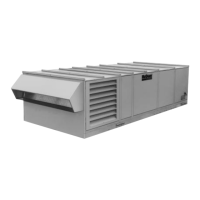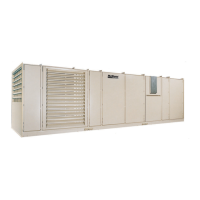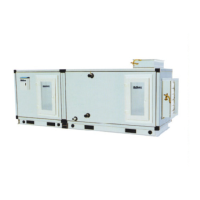IM-738 Page 53
BO4 de-energizes to close liquid line solenoid valve SV1
(line 841). As a result, compressor #1 pumps down refrigera-
tion circuit #1 until the suction pressure drops low enough to
open low pressure control LP1 (line 820). When LP1 opens,
CCB1-BO1, BO5, (BO6 and BO7) will de-energize to shut
down compressor #1 and its associated condenser fan(s).
Lead Circuit Loading
The loading and unloading process is similar except that both
compressors in the lead cooling circuit will energize before
energizing any compressors in lag circuit.
Compressor Safeties
If a compressor motor protector trips, it will immediately dis-
able its associated compressor contactor M1, 2, 3 or 4 (lines
827, 877, 832 and 882).
If high pressure switch HP3 trips (line 837), compressors #1
and #3 will be disabled and relay R1 will signal CCB1 of the
event. (line 815). CCB1 will then de-energize CCB1-BO1
and BO2 (lines 827 & 832) to keep compressors #1 and #3
locked out. If high pressure switch HP4 trips (line 887), com-
pressors #2 and #4 will be disabled and relay R2 will signal
CCB2 of the event. (line 815). CCB2 will then de-energize
CCB2-BO1 and BO2 (lines 877 & 882) to keep compressors
#2 and #4 locked out.
If frost protect switch FP1 trips (line 814), CCB1-BO4 will
de-energize (lines 841) to close SV1 and pump down circuit
#1. If frost protect switch FP2 trips (line 864), CCB2-BO4
will de-energize (lines 891) to close SV2 and pump down cir-
cuit #2. For both of these alarms, the circuit will remain off
for at least one cooling stage timer interval. If cooling is still
needed, the cooling will try to restart. The cooling will reset
up to three times in a 24 hour period (between 2:00 AM and
2:00 AM). After the third trip, the alarm will remain until
manually cleared at the keypad or over the network.
Heating
Gas Furnace, Modulating Burner (3 to 1 turn down)
Refer to “Typical Gas Furnace Control Circuit (Modulating
Burner, Mixed Air Intake)” on page 61" as you read this
sequence of operation. Note that the gas furnace wiring dia-
grams supplied with the units include a detailed sequence of
operation. Refer to the wiring diagram supplied with the unit
for exact wiring and sequence of operation information.
When system switch S1 is closed, 115 VAC power is sup-
plied to the furnace control circuit. If burner switch S3 and
safeties HL22, HL23 are closed, terminal 5 (line 615) on the
flame safeguard control (FSG) will be energized as will the
modulating gas valve VM1. If heating is enabled (MCB-BI4
is energized) and heating is required, the MCB-BO11 will
energize (line 605), thus energizing relay R20. The normally
open R20 contacts (line 610) close, and if manual burner
switch S3 and safeties HL22, HL23, FLC (high limit switch),
LP5, and HP5 are closed, terminal 6 (line 631) on the flame
safeguard control (FSG) will be energized. FSG will ener-
gize terminal 4 to start the blower motor (BM) through con-
tactor M29 (line 615). If the blower is operational, air switch
AS (line 633) will close and make FSG terminal 6 to 7. After
a 90-second prepurge period, FSG terminals 8 (line 621) and
10 (line 630) are energized. As a result, ignition transformer
IT and pilot gas valve GVI are energized. The pilot flame
will ignite and be detected by FSG through flame rod FD
(line 622). Upon detection of pilot flame after the 10 second
trial for ignition period, the FSG will de-energize terminal 10
and energize terminal 9 to energize main gas valves GV2 and
GV3 (lines 625, 626) and low fire start relay R23 (line 628).
The R23 contacts (lines 642 and 643) allow the MCB to
modulate gas valve actuator VM1 as required to satisfy the
heating demand.
Whenever the burner is operating, its firing rate will be
determined by the position of gas valve actuator VM1.
This actuator modulates the butterfly gas valve and com-
bustion air damper (lines 690 and 692), thus varying the
furnace firing rate between 33% and 100% of full capacity.
When the MCB-BO10 energizes (line 645), VM1 modu-
lates toward open and the firing rate increases. When
MCB-BO9 energizes (line 644), VM1 modulates toward
closed and the firing rate decreases. When both MCB-
BO10 and MCB-BO9 are open, VM1 holds its position and
the firing rate remains constant.
When heating is no longer necessary, MCB-BO11 opens, de-
energizing relay R20 and opening its contacts in line 610. As
a result, the flame safeguard control is de-energized, all gas
valves close, the combustion air blower motor stops, and gas
valve actuator VM1 closes. If the furnace is warm enough to
close it, the FLC fan controls switch (line 609) will override
supply fan start/stop output MCB-BO1 through R67 (line
607) and keep the supply fan running until the furnace cools
down (this might happen during night setback operation).
If the furnace overheats, the FLC high limit control (line 610)
will cycle the burner, preventing the furnace temperature
from exceeding the limit control's set point. When the fur-
nace is cycled off, low fire start relay R23 de-energizes. The
normally closed R23 contacts (line 643) cause VM1 to drive
to its minimum position, overriding MicroTech II control of
VM1 via MCB-BO10 and MCB-BO9. Because relay R23 is
de-energized whenever GV2 is de-energized, the burner will
always start at low fire.
Safety Lockout
If the pilot flame does not ignite or the flame safeguard fails
to detect its flame within 10 seconds, the flame safeguard
control will enter the "safety lockout" state. FSG terminals
4, 8,9 and 10 will be de-energized and the burner will be
shut down. FSG terminal 3 will energize relay R24 (line
633). The R24 contacts (line 244) signal the controller that
the problem exists by energizing the input to MCB-BI5. If a
safety lockout occurs, the flame safeguard control must be
manually reset.

